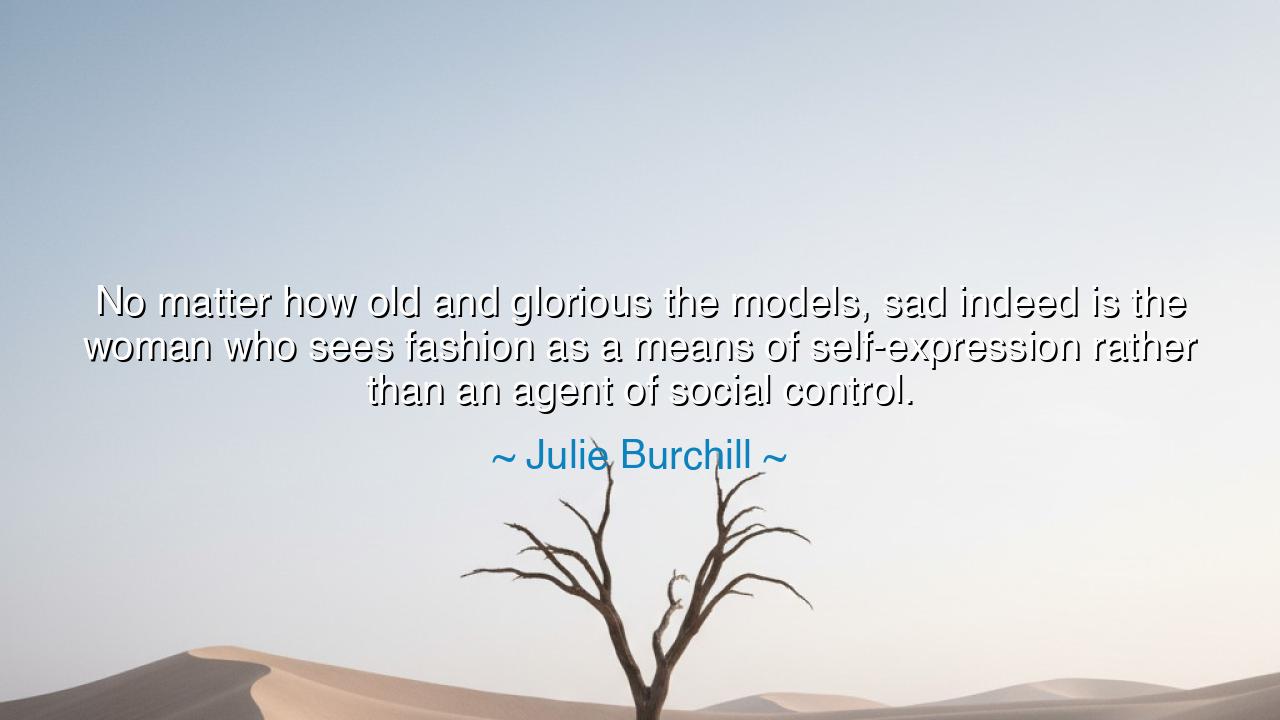
No matter how old and glorious the models, sad indeed is the
No matter how old and glorious the models, sad indeed is the woman who sees fashion as a means of self-expression rather than an agent of social control.






When Julie Burchill said, “No matter how old and glorious the models, sad indeed is the woman who sees fashion as a means of self-expression rather than an agent of social control,” she spoke with the incisive clarity of one attuned to both society and the individual psyche. Her words reveal a tension that has persisted through the ages: the delicate dance between personal expression and the subtle forces that govern human behavior. Fashion, in Burchill’s observation, is not merely about adornment or creativity; it is a reflection of cultural norms, an instrument through which societies exert influence, intentionally or not, over conduct, perception, and status.
The ancients understood this duality of adornment and influence. The Greeks and Romans, for instance, recognized that clothing, jewelry, and insignia conveyed not only beauty, but rank, virtue, and societal expectation. The toga, the stola, and the laurel wreath were not arbitrary; they were symbols through which the community communicated values and hierarchies. Burchill’s insight echoes this ancient wisdom: a woman’s fashion is rarely neutral. To mistake it for pure self-expression alone is to overlook the subtle power of social codes, and thereby risk being complicit in one’s own subordination.
Fashion as an agent of social control is visible in the lives of queens and courtiers throughout history. Consider Marie Antoinette, whose extravagant gowns and hairstyles were celebrated as individual creativity, yet also served as instruments of political and social signaling. Each ruffle and jewel projected status, allegiance, and wealth — not merely personal taste. Women who fail to recognize the controlling dimensions of fashion may find themselves trapped in invisible hierarchies, performing roles dictated by societal expectation rather than exercising genuine autonomy. Burchill’s critique is therefore both a warning and a call to awareness.
Yet there is a subtler implication in her words: the sad woman is not simply one who fails to recognize fashion’s social function, but one who misinterprets freedom. To treat clothing purely as a mirror of personal sentiment is to ignore its power to shape perception, influence interaction, and enforce conformity. The ancient Stoics taught that wisdom involves seeing the world as it is, not as we wish it to be. Similarly, Burchill suggests that true mastery of fashion — and, by extension, of life — requires acknowledging that beauty and style are embedded within societal structures, not separate from them.
History offers modern parallels as well. The suffragettes of the early 20th century, for example, wore simple, purposeful clothing that projected discipline, equality, and resolve. Their fashion was an instrument of social influence — a strategic statement rather than mere self-expression. By understanding the social power of attire, they were able to assert identity and agency simultaneously, transforming perception without sacrificing principle. Burchill’s observation, therefore, is not an attack on individuality, but a recognition that strategic awareness elevates the use of fashion beyond mere personal whim.
This insight is also philosophical: it reminds us that humans rarely act in isolation. Each gesture, appearance, and choice reverberates through the social fabric. Fashion, when wielded as self-expression without awareness, risks reinforcing constraints rather than challenging them. The ancients would have seen this as a moral lesson: to live wisely is to perceive the interplay between self and society, to act with foresight, and to harness symbols — clothing among them — in ways that advance understanding and influence.
The lesson is clear: to navigate the world with both grace and agency, one must recognize that appearances are powerful conveyors of social meaning. Fashion is not neutral; it is a language that communicates value, intention, and identity. Those who fail to grasp this risk being led by it rather than directing it. Awareness transforms clothing from passive decoration into active participation in society, enabling a woman to exercise control while maintaining personal integrity.
So, O listener, carry Burchill’s wisdom: adorn yourself not merely for the delight of personal preference, but with conscious recognition of the forces and signals embedded in society. Let every choice of attire be intentional, reflecting both self and understanding of the world. In this duality lies mastery — the ability to navigate culture with awareness, influence, and dignity, and to transform the ephemeral art of fashion into a powerful instrument of agency and wisdom.






AAdministratorAdministrator
Welcome, honored guests. Please leave a comment, we will respond soon